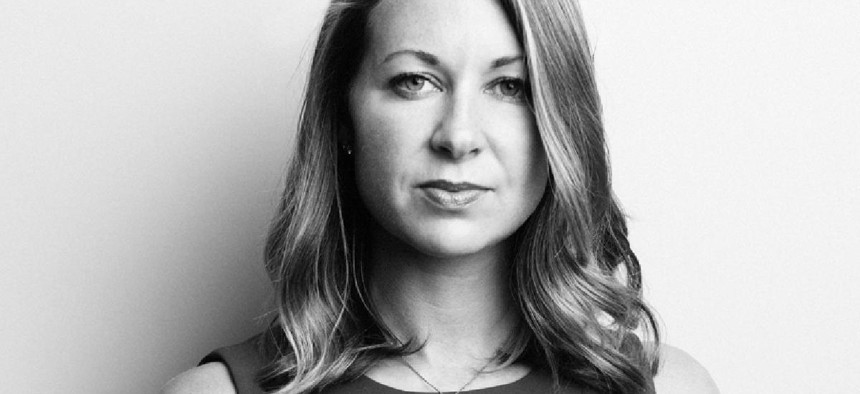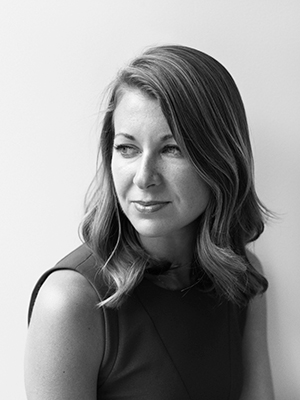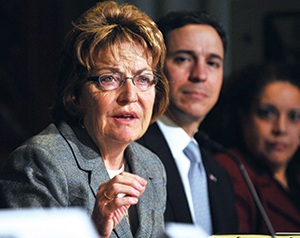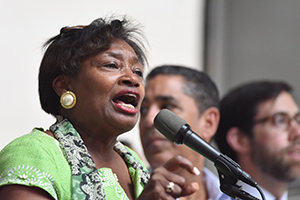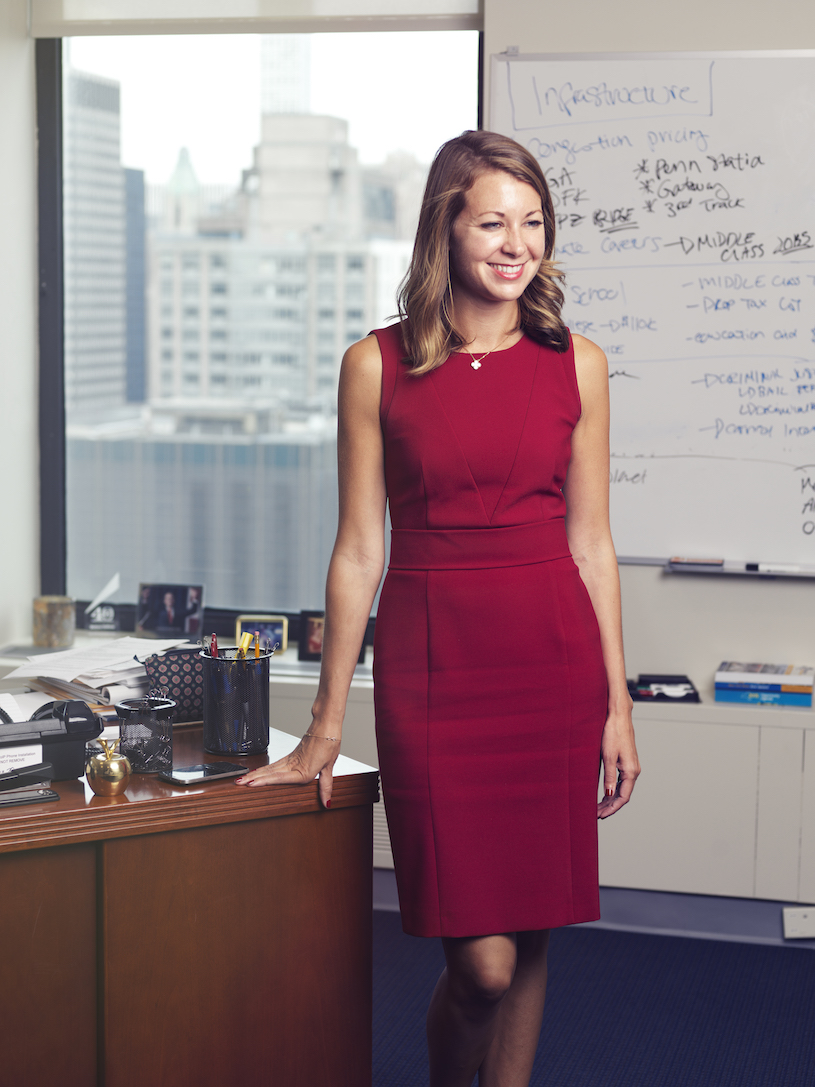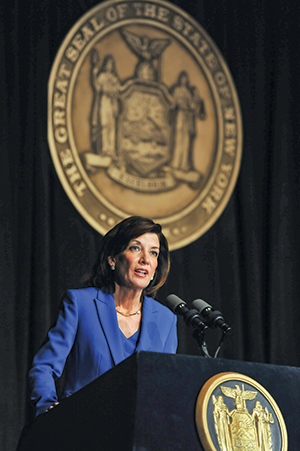When she is in New York City, Secretary to the Governor Melissa DeRosa works from the governor’s office building in midtown Manhattan, in a corner office on the 39th floor. The space feels smaller than it is, despite tall windows overlooking the surrounding cluster of skyscrapers. A couch is against one wall, a conference table sits next to another wall and a television on a small desk is tuned silently to News 12 New York. A whiteboard on the wall opposite the couch outlines some of Gov. Andrew Cuomo’s chief priorities. The office is a little cluttered, but not messy – the scattered stacks of papers on the desk reflect the scale of responsibility for the governor’s top administrative aide.
DeRosa was the first woman to be named secretary to the governor, and at 34, was among the youngest to be appointed to the post. Before this move, she was Cuomo’s chief of staff, after serving in his office for two years as communications director and strategic adviser. Her resume is a checklist of positions working for the most powerful people in New York, including Attorney General Eric Schneiderman, and the state chapter of Organizing for America, former President Barack Obama’s campaign arm. Her first internship was at age 16, for the state AFL-CIO’s political director. She received bachelor’s and master’s degrees from Cornell University.
Despite these accomplishments, DeRosa was unhappily surprised by The New York Times article that reported on her promotion on April 17, 2017. The print headline read, “Cuomo’s Chief of Staff, Daughter of a Powerful Lobbyist, Is Promoted to Secretary.” The current online version of the article does not have that title, although it does mention that DeRosa’s father, Giorgio, and her brother, Joseph, are members of the prominent lobbying firm Bolton-St. Johns before it discusses her experience. It then describes her husband Matthew Wing’s high-ranking position at Uber in Manhattan.
DeRosa, sitting cross-legged in one of the high-backed swivel chairs circling her conference table, said that she was not “upset,” but “irritated” by the coverage.
“While I am very proud of the men in my life, their professional choices don’t define me, the way that my professional choices don’t define them,” she said. She added that her predecessors as secretary to the governor, Bill Mulrow and Larry Schwartz, were generally judged by their accomplishments and not their relationships.
“Imagine if they said, ‘Larry Schwartz, the son of,’ when he got the position,” DeRosa said. Shortly after it was published, she called the editor of the article.
“I said to him, ‘I’ve been deputy chief of staff to the attorney general when I was 30. I ran Obama’s political operation at 28. I’ve managed congressional campaigns. I was the governor’s communications director, chief of staff, and now this – and you belittle all of that when you make the most defining characteristic about me who my father is,’” she remembered.
Lisa Foderaro, the Times reporter who wrote the piece, said that the editor for the Metro section, Wendell Jamieson, recalled speaking to DeRosa.
“I will say that we believe the story was fair and simply pointed out potential conflicts that the governor’s office itself had brought up in the past,” Foderaro wrote in an email, noting that the article mentioned Giorgio DeRosa’s ties to Cuomo as a possible conflict of interest, and that the secretary would recuse herself in matters relating to her father.
DeRosa believes that the real issue was the extent of coverage of her father, and she thinks that she is not unique for being judged by her relationships.
“I think that women – and men don’t even realize when they’re doing it – that women oftentimes have to overcome being seen on the basis of their gender and not on their accomplishments,” she said. “I think it takes a woman’s point of view in those senior positions to say, ‘You should never define someone this way.’”
“Until you get women in a 50/50 way, leading government, leading the corporate world, leading everything across the board – you just won’t have the same perspective,” she said.
“While I am very proud of the men in my life, their professional choices don’t define me, the way that my professional choices don’t define them.” – Secretary to the Governor Melissa DeRosa
(Celeste Sloman)
The challenge DeRosa outlined in her high-rise office is one that has dogged New York state since women obtained the right to vote 100 years ago, on Nov. 6, 1917. Women account for slightly more than 51 percent of the state’s population, and yet are underrepresented in most levels of government. Women seeking elected office are beset by challenges, from entrenched gender biases to lack of structural support. Several women in government across New York have spoken of the need for greater representation, and some are working on initiatives to encourage this participation, but the pace of progress remains maddeningly slow. As the state honors the centennial of women’s suffrage, New York is still far from achieving the goal of those who fought for the right to be represented over a century ago – true gender parity.
RELATED: A history of women's representation in New York
The march to suffrage in New York was long, with victory nearly 70 years after the pivotal Seneca Falls Convention was held in New York to demand equal rights for women. In 1915, New York held its first referendum on suffrage, which failed. According to Susan Goodier, a lecturer at SUNY Oneonta who recently co-wrote a book on the 1917 milestone, only voters – by default, men – were allowed to decide the issue.
Suffragists were able to turn the tide of public opinion after the first vote with a vigorous campaign that included parades and public support for the ongoing war effort. By 1917, they had convinced a constituency of men who had not cast a ballot in the first referendum to come to their side for the second one.
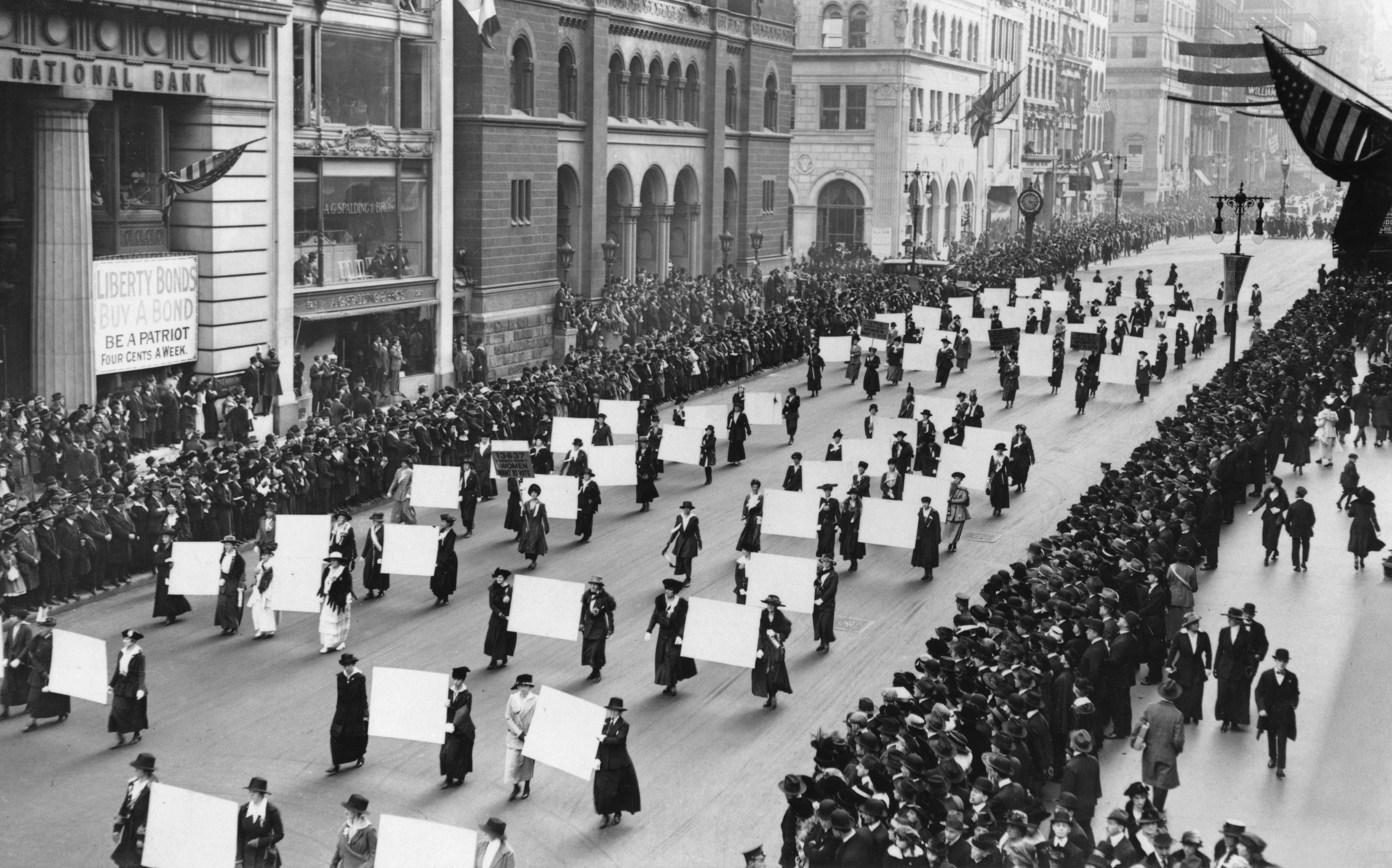
Suffragists march down Fifth Avenue in October 1917, displaying placards containing the signatures of more than 1 million New York women demanding the right to vote. (The New York Times/Redux)
The first two women to serve in the Assembly were elected in 1919, and the first one to be sent to the state Senate was elected in 1935. New York had several prominent female leaders in the 20th century, from Shirley Chisholm to Geraldine Ferraro. But looking simply at the numbers, New York is still far from achieving equal representation.
There are 10 women in the New York congressional delegation, out of 27 House members and two senators. In the 213-member state Legislature, there are currently 59 women – 14 in the Senate and 45 in the Assembly. In the New York City Council, the representative body for the largest city in the country, there are only 13 women out of 51 seats. That number is set to decrease, leaving at most 12 in January, when the new council is seated.
“To have a legislative body in a city like New York, progressive, where you have such an incredible gender disparity – it really does matter,” said outgoing City Council Speaker Melissa Mark-Viverito, who is spearheading a campaign to get 21 women elected to the council by 2021.
RELATED: Women lose ground in the City Council
The news is not universally negative. Lt. Gov. Kathy Hochul noted that Rochester, Syracuse and Albany are led by female mayors. However, she added that the majority-male governments in her home constituencies of Buffalo and Erie County are glaring examples of unequal representation in Western New York.
There are a number of female commissioners in the state, and both the secretary to the governor and Cuomo’s chief of staff are women. Nevertheless, the glacial pace of progress grates on many of the state’s most prominent female lawmakers.
There has also been a steady increase in women appointed to state and federal judgeships throughout New York, according to Dina Refki, the director of the Center for Women in Government and Civil Society at the University at Albany.
“We’re not where we need to be at all,” state Senate Minority Leader Andrea Stewart-Cousins said.
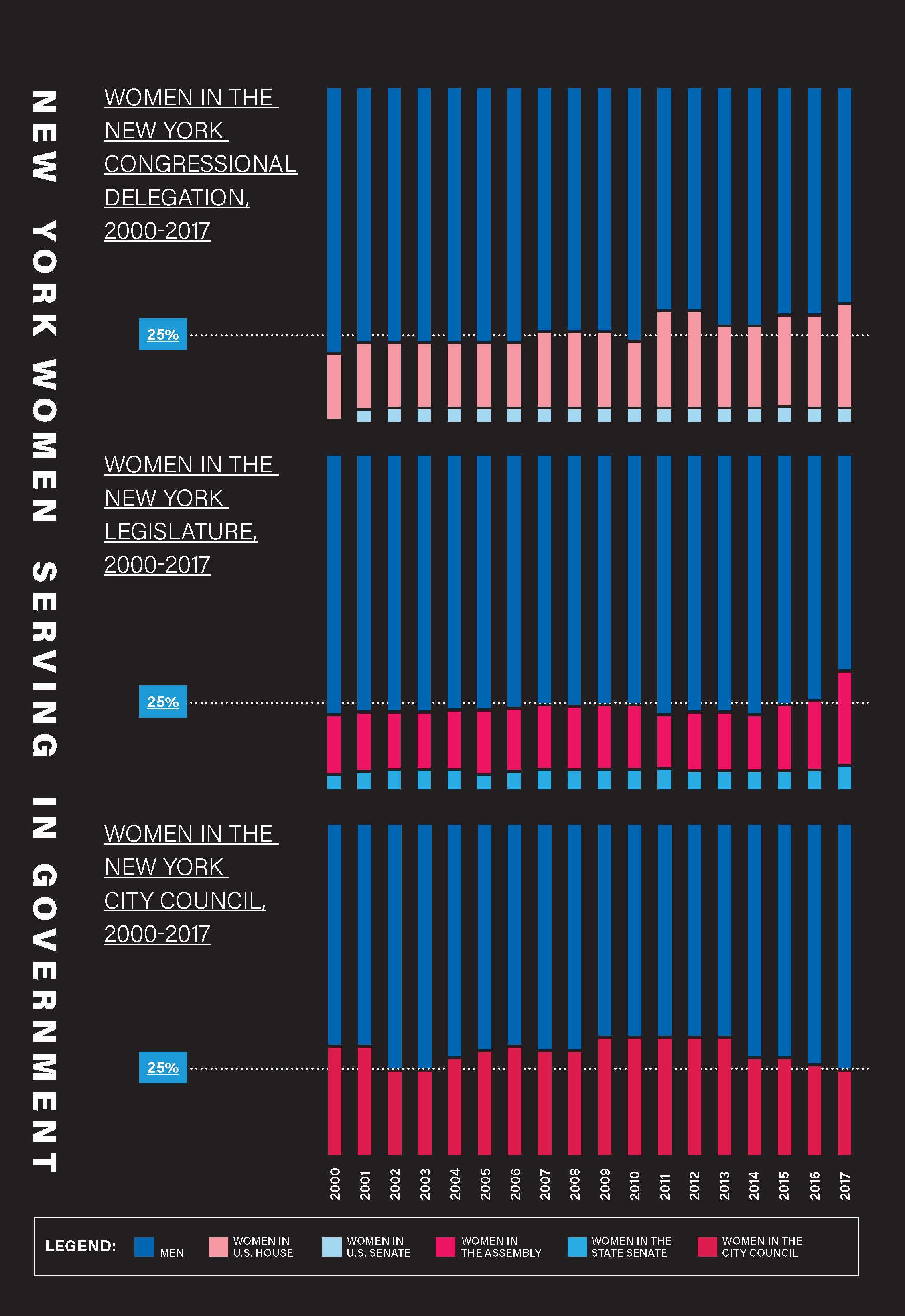
Republican state Sen. Betty Little believes New York has seen enormous improvement in gender representation since she was first elected to the Warren County Board of Supervisors in 1986.
“You have more camaraderie in government than you used to have because there are more women involved,” she said.
Little was inspired to enter politics because the board was considering a proposal for a waste-to-energy plant. She believed that it would be too expensive, and that the county would not have enough control over its operations. Despite her opposition, the board voted to go forward with the plant, which Little said cost the county millions of dollars, and is now privately owned.
“I’m not sure my opinion was as respected as it would have been if had I been a man,” Little said. At times during her tenure, she was the sole woman on the board. “It was just like, ‘OK, this is this little housewife that came in and has an opinion different from ours.’”
Little then served in the Assembly for several years before being elected to the state Senate in 2002. She has seen public office become less of a boys club in her ascent. When she was first elected, she said that women were the “exception” – in comparison, today’s government is far more representative.
But while progress has undoubtedly been made, women are still too often excluded. Kelly Dittmar, an assistant professor and scholar at the Center for American Women and Politics at Rutgers University, has researched the reasons for the relative dearth in female candidates. She found that women do not lack political ambition, but that they calculate that the costs of running will outweigh the benefits.
Women are especially hesitant to bear these costs if they see government as ineffective. Dittmar said that research suggests they primarily run for office to make a difference, whereas men run for prestige. Potential female candidates need to see governing as a way to shape policy.
For Little, it was the waste plant. Rep. Louise Slaughter, the longest-serving woman in New York’s congressional caucus, was motivated to enter politics because of her passion for environmental issues, specifically fighting to preserve trees in her community. She believes that it is necessary for women to have a purpose when they run for office.
“You don’t go for yourself,” Slaughter said. “You have to be driven by a cause. I can’t imagine anything else would have ever drawn me out to really go out and ask people to vote for me and to trust me.”
After a woman has decided to run, she may continue to face obstacles throughout her campaign, including gender bias. According to Maria D’Agostino, an associate professor and co-founder of the Women in the Public Sector program at John Jay College of Criminal Justice, people traditionally conceive of leadership in masculine terms. If a woman displays too few “male” qualities, then she isn’t qualified to be a leader. But if she is too ambitious or assertive, voters no longer see her as acting appropriately feminine, and are still turned off.
“I think that every woman in high-profile positions would say that there seems to be some sort of higher level of scrutiny,” Stewart-Cousins said.
In August, hedge fund manager and Cuomo donor Daniel Loeb made racially charged comments on Facebook about Stewart-Cousins, suggesting that her support for teachers unions made her more damaging to the black community than the Ku Klux Klan. His comments were made in response to an article in the Times, in which Stewart-Cousins accused Cuomo of dismissing her experience based on her race and gender.
Stewart-Cousins laughed when recalling the Loeb incident, saying that it brought her good press. She believes that while discriminatory behavior may be unacceptable, women who want to be in public positions have to be tough enough to handle it.
“We do get a different level of aggression sometimes than our white male counterparts would get, but it’s OK,” she said. “Even if I’m unfairly maligned or targeted or insulted, I still move forward with the strength of my conviction.”
DeRosa also noted that everyday encounters with sexism can discourage women from seeking leadership positions. But, like Stewart-Cousins, she stands defiant.
“I think there are a lot of strong successful women who go the other way, and say, ‘I’m going to fight back,’” she said.
“They're always saying, ‘There ought to be more women doing this,’ but sometimes I think a lot of women don't really want to do that.” – state Sen. Betty Little
(John Carl D’Annibale/Times Union)
Traditional gender roles present another barrier to seeking office. Women are often caregivers in their families, and may need to consider the needs of their relatives or children when making career decisions. If running for office conflicts with this role, a woman may avoid taking that step.
“It’s a 24-hour job to campaign, and to mount a successful election campaign, that requires dedication of all of your time,” Refki explained. The difficult hours and travel requirements are compounded by a lack of structural support for women with young children once they are elected to office. D’Agostino called this the “glass cliff” – even if women do make it to office, they are set up to fail.
Little was a stay-at-home mother of six before she entered politics. Her youngest child was 15 when she was elected to the board. Her new career involved a lot of “juggling” and travel, and she occasionally missed important events.
“They’re always saying, ‘There ought to be more women doing this,’ but sometimes I think a lot of women don’t really want to do that, and don’t want to be away from home the way you would have to be in the state Legislature,” Little said.
Hochul was a congresswoman before becoming lieutenant governor, and lost to current Rep. Chris Collins in 2014 in a particularly bitter campaign. She believes that women with families should be encouraged to run for office and sees herself as being in a position to inspire them.
“I know the sacrifices that are made on their families. I know how hard it can be when in a campaign and there’s a lot of negativity, and TV ads run against you, and your children and your parents have to see that,” she said. “Who better than me to say, ‘No, you can do this as well’?”
RELATED: What the covfefe happened to political discourse?
Party leadership at the state and federal level is dominated by white men who usually choose to recruit other white men to run for office. According to Christina Greer, an associate professor of political science at Fordham University, this pattern is especially apparent in New York, where entrenched party machines create a particularly challenging political terrain. Mark-Viverito said she’s facing these barriers in New York City as she attempts to elect more women to the council.
“There are some county structures that have not endorsed women, despite the fact that there are qualified women running,” she said.
Structural challenges are compounded for women of color, who experience racism as well as sexism when seeking higher office. Glynda Carr co-founded Higher Heights, a New York-based nonprofit, which helps black women run for office to circumvent party machines. Although black women were elected in higher numbers in 2016, they are still greatly underrepresented. Higher Heights trains women to run and govern because local leaders often aren’t eager to do so.
“Black women not only aren’t encouraged to run for office, they actually are discouraged to run for office at times,” she said.
RELATED: The rise of female lawmakers of color in Albany
Greer said that women have to be asked an average of seven times by people they trust to run for office before even considering it, and women of color are especially reluctant. Stewart-Cousins remembered how she had to be asked to run for office, and how she would never have considered it as a possibility otherwise.
“I never saw anybody in public office – certainly not a senator or anybody like that – who reflected me,” she recalled. “I think we have seen, especially in the political arena, a majority of white men, and I think many times women just felt like this wasn’t where they ought to be.”
“I never saw anybody in public office – certainly not a senator or anybody like that – who reflected me.” – state Senate Minority Leader Andrea Stewart-Cousins
(a katz/Shutterstock)
The 2016 presidential election lurks underneath any discussion of women in state government, challenging the assumptions of a supposedly more progressive era. The first female presidential nominee of a major party was defeated by a man who had publicly disparaged women – and both were New Yorkers.
Hochul and DeRosa referred to Hillary Clinton as a trailblazer for championing women’s issues and nearly becoming president. D’Agostino and Refki mentioned her as a symbol of the tragically slow march of progress for women to gain representation. Carr and Stewart-Cousins indicated that instead of dampening enthusiasm to run, Clinton’s loss in the 2016 election has mobilized more women to become involved in politics, with Carr saying her organization had seen an increase in black female candidates.
For DeRosa, the question of promoting women to become leaders has to be examined in a national context. For four years, Albany and Washington followed what DeRosa called “complementary” policy tracks. She cited the example of Cuomo signing pay equity legislation years after Obama had signed the Lilly Ledbetter Fair Pay Act on the federal level.
“We lived in a different reality a year ago when you had Barack Obama in the White House,” she said.
The election of President Donald Trump was “devastating” for DeRosa, but it inspired the creation of the New York State Council on Women and Girls. She was motivated to take action after Hope Hicks, now the White House communications director, said that the original White House Council on Women and Girls established by Obama was “redundant.” It has been dormant since the inauguration.
DeRosa said that Cuomo led internal discussions on how to address women’s issues in New York state, and the council was a culmination of those efforts. It launched in August with DeRosa as the chairwoman, and includes the commissioners of every state department to ensure that women’s “unique needs” are considered by every agency. DeRosa is adamant that these needs shouldn’t simply be defined through the lens of issues such as reproductive rights – which she does consider vital – but with the understanding that all policies affect women.
The council also includes a steering committee composed of female leaders from business, media, academia and nonprofit organizations. DeRosa wants to ensure that this council is not simply a public relations effort, but will actually promote women and girls and encourage them to strive for leadership positions.
“The things we can do on our own through executive action, we’re going to do on our own, and the things we need to legislatively we’ll gear up for, but it felt like the perfect antidote to what we were seeing in Washington,” she said.
RELATED: Honoring 25 of New York's most remarkable women
Alongside the forward-looking council is the New York State Women’s Suffrage Commission led by Hochul. The commission is sponsoring women- and suffrage-related events through 2020, the centennial of women obtaining the right to vote nationally. It is also providing promotional material celebrating the milestones, such as custom “I Voted” stickers that feature a suffragist and will be distributed on Election Day.
Hochul takes her duty as chairwoman seriously, and pushed for the addition of an advisory committee to ensure greater diversity. She enjoys attending commission events, from visiting schools to holding forums to promoting the suffrage-related landmarks across the state.
“It always draws an applause line when I give the speech to any group and I say it’s the 100th anniversary of women’s suffrage,” she said.
“Until you get women in a 50/50 way, leading government, leading the corporate world, leading everything across the board – you just won’t have the same perspective.” – Melissa DeRosa, secretary to the governor
(Celeste Sloman)
Beyond state initiatives to promote and celebrate women, several politicians spoke of the need to create a pipeline to leadership. For DeRosa, it is a matter of access. Although she does not think her father’s career defines her, she recognizes that he introduced her to the political realm. She showed a photo of herself attending the 1992 Democratic National Convention as a child, smiling widely as she was lifted in the air to see the proceedings.
“I think that I only got here because at age 8, I said, ‘Dad, can you take me to your meetings,’ and I would sit with him in the Capitol as he was negotiating with legislators,” DeRosa recalled. She was able to ask for an internship with the political director of the state AFL-CIO as a teenager because she had met her through her father.
In the Times article, DeRosa’s influential father is an important asterisk to her position in New York government. To her, the reality is more nuanced; her accomplishments are her own, but her road to becoming secretary would not have been available had she not been raised with access to the political arena.
“It sets you on a path, and you have to have a level of access and a level of exposure that I think a lot of women don’t get,” she said.
Certain groups of women struggle more to obtain this access. According to Dittmar, Republican women in particular lack structural support when running for office, as there are few outside organizations promoting their election, and biases among party voters persist about women being more moderate. Rep. Elise Stefanik, a congresswoman who represents the North Country and the youngest woman elected to Congress, said she is trying to create a pipeline for Republican women in her role overseeing recruitment for the National Republican Congressional Committee.
Women of color perhaps face the greatest challenges when seeking higher office. Stewart-Cousins recalled that she never saw herself in government partly because no path to higher advancement had been made available to her parents.
“They were victims of a time – pre-civil rights era – where neither of my parents were able to live to their fullest potential in terms of jobs and their abilities to contribute because of the prejudice and the lack of opportunity,” she said. As a black woman who rose to a top position in state government, she can now help others see government as a viable career.
“As more and more women are seen in this position, then I think more and more women will be inspired,” she said.
“How will we be judged 100 years from now, when people commemorate the bicentennial of women’s right to vote in this state?” – Lt. Gov. Kathy Hochul
(Darren McGee/Office of the Governor)
Women in government offer different methods of governing and coalition-building, and raise important issues for underrepresented constituencies, but Dittmar said that she has come across frustration by some lawmakers at being boxed into legislating on “women’s issues.”
According to D’Agostino, there shouldn’t even be a question of why gender parity is necessary, and what “women’s issues” represent.
“Men don’t have to justify why we need them in government, and the decisions that they make,” she said.
Many of the female lawmakers insisted that it is important to get more women in government, while maintaining that “women’s issues” are universal and not niche.
“I think that women’s issues affect families. I think they affect children. I think they affect bosses and I think they really should be thought of as human rights not women’s rights,” DeRosa said.
“Tax policy, economic development, education, health care, national security, agriculture all impact women in my district, so I treat every issue as a woman’s issue in my congressional office,” Stefanik said.
“What issue isn’t a women’s issue?” Little asked.
At the same time, many recognized the obligation they may have to advocate for the perspectives of women while legislating. Little recalled her advocacy on the board of supervisors and in the Assembly on behalf of “displaced homemakers” – women entering the workforce for the first time due to death or divorce – because her male colleagues didn’t recognize it as an important labor issue.
The line between “women’s issues” and everyday issues is often blurred. DeRosa recalled her work pushing for a $15 minimum wage in the state. Although it was seen as primarily an economic matter, it affected women specifically.
“When you actually look at the demographics of who fast food workers are, disproportionately it’s single women,” she said about the laborers she considered while working on the legislation. She also discussed the importance of implementing paid family leave in tandem, as it intersects with women’s career considerations.
Despite their reluctance to be pigeonholed, women often do take pride in being in a position to represent their gender. DeRosa called it “exciting” to work on issues that affect women, showing them that someone is representing their interests at the highest levels of government.
Beyond offering different perspectives, gender parity is critical to the functioning of the state and country, as a truly representative democracy requires that each segment of the population has a voice.
“It’s incredibly important that more women are raising their voices, getting involved in politics, and serving in government,” said U.S. Sen. Kirsten Gillibrand, who founded the Off the Sidelines PAC to raise funds for female candidates and encourage women and girls to engage in politics. “All of these issues affect us, and if we don’t participate, we may not like the decisions that are made,” she said.
Hochul believes that remembering the centennial of women’s suffrage is critical when considering current representation. Whenever she addresses groups for the Women’s Suffrage Commission, she said that she reminds them of the sacrifices suffragists made to advance women’s causes.
“I put on them the question of how we will be judged 100 years from now, when people commemorate the bicentennial of women’s right to vote in this state,” she said. “Will we hold up to that scrutiny in terms of our contributions? Is what we have done comparable to what our foremothers did to improve the status of women and children in the state?”
Correction: An earlier version of this story incorrectly referred to a director of the state AFL-CIO as a man. In fact, the person is woman.

